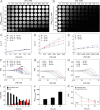Trapped in Endosome PEGylated Ultra-Small Iron Oxide Nanoparticles Enable Extraordinarily High MR Imaging Contrast for Hepatocellular Carcinomas
- PMID: 39162181
- PMCID: PMC11497028
- DOI: 10.1002/advs.202401351
Trapped in Endosome PEGylated Ultra-Small Iron Oxide Nanoparticles Enable Extraordinarily High MR Imaging Contrast for Hepatocellular Carcinomas
Abstract
The early diagnosis of hepatocellular carcinomas (HCCs) remains challenging in the clinic. Primovist-enhanced magnetic resonance imaging (MRI) aids HCC diagnosis but loses sensitivity for tumors <2 cm. Therefore, developing advanced MRI contrast agents is imperative for improving the diagnostic accuracy of HCCs in very-early-stage. To address this challenge, PEGylated ultra-small iron oxide nanoparticles (PUSIONPs) are synthesized and employed as liver-specific T1 MRI contrast agents. Intravenous delivery produces simultaneous hyperintense HCC and hypointense hepatic parenchyma signals on T1 imaging, creating an extraordinarily high tumor-to-liver contrast. Systematic studies uncover PUSIONP distribution in hepatic parenchyma, HCC lesions at the organ, tissue, cellular, and subcellular levels, revealing endosomal confinement of PUSIONP without aggregation. By mimicking such situations, the dependency of relaxometric properties on local PUSIONP concentration is investigated, emphasizing the key role of different endosomal concentrations in liver and tumor cells for high tumor-to-liver contrast and clear tumor boundaries. These findings offer exceptional imaging capabilities for early HCC diagnosis, potentially benefiting real HCC patients.
Keywords: contrast agent; early diagnosis; hepatocellular carcinoma; iron oxide nanoparticle.
© 2024 The Author(s). Advanced Science published by Wiley‐VCH GmbH.
Conflict of interest statement
The authors declare no conflict of interest.
Figures









Similar articles
-
Targeted MR Imaging Adopting T1-Weighted Ultra-Small Iron Oxide Nanoparticles for Early Hepatocellular Carcinoma: An in vitro and in vivo Study.Chin Med Sci J. 2020 Jun 30;35(2):142-150. doi: 10.24920/003643. Chin Med Sci J. 2020. PMID: 32684234
-
Ultrasmall Paramagnetic Iron Oxide Nanoprobe Targeting Epidermal Growth Factor Receptor for In Vivo Magnetic Resonance Imaging of Hepatocellular Carcinoma.Bioconjug Chem. 2017 Nov 15;28(11):2794-2803. doi: 10.1021/acs.bioconjchem.7b00501. Epub 2017 Oct 20. Bioconjug Chem. 2017. PMID: 28972742
-
Sialic acid-engineered mesoporous polydopamine dual loaded with ferritin gene and SPIO for achieving endogenous and exogenous synergistic T2-weighted magnetic resonance imaging of HCC.J Nanobiotechnology. 2021 Mar 17;19(1):76. doi: 10.1186/s12951-021-00821-8. J Nanobiotechnology. 2021. PMID: 33731140 Free PMC article.
-
Gadoxetic acid-enhanced MR imaging for hepatocellular carcinoma: molecular and genetic background.Eur Radiol. 2020 Jun;30(6):3438-3447. doi: 10.1007/s00330-020-06687-y. Epub 2020 Feb 16. Eur Radiol. 2020. PMID: 32064560 Review.
-
Multidetector row CT and MR imaging in diagnosing hepatocellular carcinoma.Intervirology. 2004;47(3-5):209-26. doi: 10.1159/000078474. Intervirology. 2004. PMID: 15383731 Review.
Cited by
-
Neurological Emergency Treatment Strategy: A Neuron-Targeted Regulation System for Reactive Oxygen Species Metabolism through Ferroptosis Modulation.ACS Nano. 2025 Mar 11;19(9):8753-8772. doi: 10.1021/acsnano.4c15705. Epub 2025 Feb 25. ACS Nano. 2025. PMID: 39996314
References
-
- a) Siegel R. L., Miller K. D., Fuchs H. E., Jemal A., CA Cancer J. Clin. 2022, 72, 7; - PubMed
- b) Lu J., Sun J., Li F., Wang J., Liu J., Kim D., Fan C., Hyeon T., Ling D., J. Am. Chem. Soc. 2018, 140, 10071; - PubMed
- c) Lee Y. L., Lee J. M., Lee J. S., Lee H. Y., Park B. H., Kim Y. H., Han J. K., Choi B. I., Radiology 2015, 275, 97; - PubMed
- d) Forner A., Llovet J. M., Bruix J., Lancet 2012, 379, 1245. - PubMed
-
- a) Galle P. R., Forner A., Llovet J. M., Mazzaferro V., Piscaglia F., Raoul J. L., Schirmacher P., Vilgrain V., J. Hepatol. 2018, 69, 182; - PubMed
- b) Marrero J. A., Kulik L. M., Sirlin C. B., Zhu A. X., Finn R. S., Abecassis M. M., Roberts L. R., Heimbach J. K., Hepatology 2018, 68, 723; - PubMed
- c) Reig M., Forner A., Rimola J., Ferrer‐Fabrega J., Burrel M., Garcia‐Criado A., Kelley R. K., Galle P. R., Mazzaferro V., Salem R., Sangro B., Singal A. G., Vogel A., Fuster J., Ayuso C., Bruix J., J. Hepatol. 2022, 76, 681; - PMC - PubMed
- d) Nur Syafiqah Abu Bakar F. S. S., Mahmud M. H., Healthscope 2019, 1, 143;
- e) Jia Z., Song L., Zang F., Song J., Zhang W., Yan C., Xie J., Ma Z., Ma M., Teng G., Gu N., Zhang Y., Theranostics 2016, 6, 1780. - PMC - PubMed
-
- El‐Serag H. B., Marrero J. A., Rudolph L., Reddy K. R., Gastroenterology 2008, 134, 1752. - PubMed
MeSH terms
Substances
Grants and funding
LinkOut - more resources
Full Text Sources
Medical
